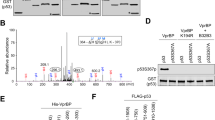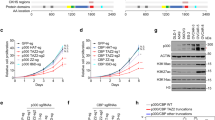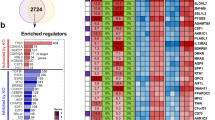Abstract
Numerous studies indicate that p300 acts as a key transcriptional cofactor in vivo, at least, in part, by modulating activities of p53 by acetylation. Nevertheless, the regulation of the p53-p300 interplay is not completely understood. Here, we have identified the DEAD (Asp-Glu-Ala-Asp) box RNA helicase 24 (DDX24) as a novel regulator of the p300-p53 axis. We found that DDX24 interacts with p300, and this interaction leads to suppression of p300-mediated acetylation of p53. Notably, RNA interference-mediated knockdown of endogenous DDX24 significantly increases the acetylation levels of endogenous p53 in human cancer cells and subsequently promotes p53-mediated activation of its transcriptional targets such as p21 and p53 upregulated modulator of apoptosis (PUMA). In contrast, DDX24 expression inhibits the p300-p53 interaction and suppresses p300-mediated acetylation of p53. Moreover, DDX24 is overexpressed in human cancer cells and reduction of DDX24 protein levels by RNA interference induces cell cycle arrest and senescence in a p53-dependent manner. These results reveal DDX24 as an important regulator of p300 and suggest that the modulation of the p53-p300 interplay by DDX24 is critical in controlling p53 activities in human cancer cells.
This is a preview of subscription content, access via your institution
Access options
Subscribe to this journal
Receive 50 print issues and online access
$259.00 per year
only $5.18 per issue
Buy this article
- Purchase on Springer Link
- Instant access to full article PDF
Prices may be subject to local taxes which are calculated during checkout






Similar content being viewed by others
References
Olivier M, Hollstein M, Hainaut P . TP53 mutations in human cancers: origins, consequences, and clinical use. Cold Spring Harb Perspect Biol 2010; 2: a001008.
Dai C, Gu W . p53 post-translational modification: deregulated in tumorigenesis. Trends Mol Med 2010; 16: 528–536.
Kruse JP, Gu W . Modes of p53 regulation. Cell 2009; 137: 609–622.
Tang Y, Zhao W, Chen Y, Zhao Y, Gu W . Acetylation is indispensable for p53 activation. Cell 2008; 133: 612–626.
Shi D, Gu W . Dual roles of MDM2 in the regulation of p53: ubiquitination dependent and ubiquitination independent mechanisms of MDM2 repression of p53 activity. Genes Cancer 2012; 3: 240–248.
Charvet C, Wissler M, Brauns-Schubert P, Wang SJ, Tang Y, Sigloch FC et al. Phosphorylation of Tip60 by GSK-3 determines the induction of PUMA and apoptosis by p53. Mol Cell 2011; 42: 584–596.
Tang Y, Luo JY, Zhang WZ, Gu W . Tip60-dependent acetylation of p53 modulates the decision between cell-cycle arrest and apoptosis. Mol Cell 2006; 24: 827–839.
Gu W, Roeder RG . Activation of p53 sequence-specific DNA binding by acetylation of the p53 C-terminal domain. Cell 1997; 90: 595–606.
Iyer NG, Ozdag H, Caldas C . p300/CBP and cancer. Oncogene 2004; 23: 4225–4231.
Vervoorts J, Luscher-Firzlaff JM, Rottmann S, Lilischkis R, Walsemann G, Dohmann K et al. Stimulation of c-MYC transcriptional activity and acetylation by recruitment of the cofactor CBP. EMBO Rep 2003; 4: 484–490.
Yao TP, Oh SP, Fuchs M, Zhou ND, Ch'ng LE, Newsome D et al. Gene dosage-dependent embryonic development and proliferation defects in mice lacking the transcriptional integrator p300. Cell 1998; 93: 361–372.
Iyer NG, Xian J, Chin SF, Bannister AJ, Daigo Y, Aparicio S et al. p300 is required for orderly G1/S transition in human cancer cells. Oncogene 2007; 26: 21–29.
Gayther SA, Batley SJ, Linger L, Bannister A, Thorpe K, Chin SF et al. Mutations truncating the EP300 acetylase in human cancers. Nat Genet 2000; 24: 300–303.
Mullighan CG, Zhang J, Kasper LH, Lerach S, Payne-Turner D, Phillips LA et al. CREBBP mutations in relapsed acute lymphoblastic leukaemia. Nature 2011; 471: 235–239.
Pasqualucci L, Dominguez-Sola D, Chiarenza A, Fabbri G, Grunn A, Trifonov V et al. Inactivating mutations of acetyltransferase genes in B-cell lymphoma. Nature 2011; 471: 189–195.
Peifer M, Fernandez-Cuesta L, Sos ML, George J, Seidel D, Kasper LH et al. Integrative genome analyses identify key somatic driver mutations of small-cell lung cancer. Nat Genet 2012; 44: 1104.
Shikama N, Lee CW, France S, Delavaine L, Lyon J, Krstic-Demonacos M et al. A novel cofactor for p300 that regulates the p53 response. Mol cell 1999; 4: 365–376.
Zhao Y, Yu L, Fu Q, Chen W, Jiang J, Gao J et al. Cloning and characterization of human DDX24 and mouse Ddx24, two novel putative DEAD-Box proteins, and mapping DDX24 to human chromosome 14q32. Genomics 2000; 67: 351–355.
Gustafson EA, Wessel GM . DEAD-box helicases: posttranslational regulation and function. Biochem Biophys Res Commun 2010; 395: 1–6.
Cordin O, Banroques J, Tanner NK, Linder P . The DEAD-box protein family of RNA helicases. Gene 2006; 367: 17–37.
Fuller-Pace FV . DEAD box RNA helicase functions in cancer. RNA Biol 2013; 10: 121–132.
Fuller-Pace FV . DExD/H box RNA helicases: multifunctional proteins with important roles in transcriptional regulation. Nucleic Acids Res 2006; 34: 4206–4215.
Abdelhaleem M . Do human RNA helicases have a role in cancer? Biochem Biophys Acta 2004; 1704: 37–46.
Cruciat CM, Dolde C, de Groot RE, Ohkawara B, Reinhard C, Korswagen HC et al. RNA helicase DDX3 is a regulatory subunit of casein kinase 1 in Wnt-beta-catenin signaling. Science 2013; 339: 1436–1441.
Fukawa T, Ono M, Matsuo T, Uehara H, Miki T, Nakamura Y et al. DDX31 regulates the p53-HDM2 pathway and rRNA gene transcription through its interaction with NPM1 in renal cell carcinomas. Cancer Res 2012; 72: 5867–5877.
Fuller-Pace FV, Ali S . The DEAD box RNA helicases p68 (Ddx5) and p72 (Ddx17): novel transcriptional co-regulators. Biochem Soc Trans 2008; 36: 609–612.
Jung SY, Malovannaya A, Wei J, O'Malley BW, Qin J . Proteomic analysis of steady-state nuclear hormone receptor coactivator complexes. Mol Endocrinol 2005; 19: 2451–2465.
Kundu TK, Palhan VB, Wang Z, An W, Cole PA, Roeder RG . Activator-dependent transcription from chromatin in vitro involving targeted histone acetylation by p300. Mol Cell 2000; 6: 551–561.
Szerlong HJ, Prenni JE, Nyborg JK, Hansen JC . Activator-dependent p300 acetylation of chromatin in vitro: enhancement of transcription by disruption of repressive nucleosome-nucleosome interactions. J Biol Chem 2010; 285: 31954–31964.
Oren M, Damalas A, Gottlieb T, Michael D, Taplick J, Leal JF et al. Regulation of p53: intricate loops and delicate balances. Ann N Y Acad Sci 2002; 973: 374–383.
Delvecchio M, Gaucher J, Aguilar-Gurrieri C, Ortega E, Panne D . Structure of the p300 catalytic core and implications for chromatin targeting and HAT regulation. Nat Struct Mol Biol 2013; 20: 1040–1046.
Shi D, Pop MS, Kulikov R, Love IM, Kung AL, Grossman SR . CBP and p300 are cytoplasmic E4 polyubiquitin ligases for p53. Proc Natl Acad Sci USA 2009; 106: 16275–16280.
Grossman SR, Perez M, Kung AL, Joseph M, Mansur C, Xiao ZX et al. p300/MDM2 complexes participate in MDM2-mediated p53 degradation. Mol Cell 1998; 2: 405–415.
Zhao H, Darzynkiewicz Z . Biomarkers of cell senescence assessed by imaging cytometry. Methods Mol Biol 2013; 965: 83–92.
Wang Y, Blandino G, Givol D . Induced p21waf expression in H1299 cell line promotes cell senescence and protects against cytotoxic effect of radiation and doxorubicin. Oncogene 1999; 18: 2643–2649.
Franken NA, Rodermond HM, Stap J, Haveman J, van Bree C . Clonogenic assay of cells in vitro. Nat Protoc 2006; 1: 2315–2319.
Yamauchi T, Nishiyama M, Moroishi T, Yumimoto K, Nakayama KI . MDM2 mediates nonproteolytic polyubiquitylation of the DEAD-Box RNA helicase DDX24. Mol Cell Biol 2014; 34: 3321–3340.
Coutts AS, La Thangue NB . The p53 response: emerging levels of co-factor complexity. Biochem Biophys Res Commun 2005; 331: 778–785.
Ma Z, Moore R, Xu X, Barber GN . DDX24 negatively regulates cytosolic RNA-mediated innate immune signaling. Plos Pathog 2013; 9: e1003721.
Johnson RF, Perkins ND . Nuclear factor-kappaB, p53, and mitochondria: regulation of cellular metabolism and the Warburg effect. Trends Biochem Sci 2012; 37: 317–324.
Busuttil V, Droin N, McCormick L, Bernassola F, Candi E, Melino G et al. NF-kappaB inhibits T-cell activation-induced, p73-dependent cell death by induction of MDM2. Proc Natl Acad Sci USA 2010; 107: 18061–18066.
Thomasova D, Mulay SR, Bruns H, Anders HJ . p53-independent roles of MDM2 in NF-kappaB signaling: implications for cancer therapy, wound healing, and autoimmune diseases. Neoplasia 2012; 14: 1097–1101.
Zhu YH, Bulavin DV . Wip1-dependent signaling pathways in health and diseases. Prog Mol Biol Transl Sci 2012; 106: 307–325.
Chao CH, Chen CM, Cheng PL, Shih JW, Tsou AP, Lee YH . DDX3 a DEAD box RNA helicase with tumor growth-suppressive property and transcriptional regulation activity of the p21waf1/cip1 promoter, is a candidate tumor suppressor. Cancer Res 2006; 66: 6579–6588.
Nakagawa Y, Morikawa H, Hirata I, Shiozaki M, Matsumoto A, Maemura K et al. Overexpression of rck/p54, a DEAD box protein, in human colorectal tumours. Br J Cancer 1999; 80: 914–917.
Payne EM, Bolli N, Rhodes J, Abdel-Wahab OI, Levine R, Hedvat CV et al. Ddx18 is essential for cell-cycle progression in zebrafish hematopoietic cells and is mutated in human AML. Blood 2011; 118: 903–915.
Dimri GP, Lee XH, Basile G, Acosta M, Scott C, Roskelley C et al. A biomarker that identifies senescent human-cells in culture and in aging skin in-vivo. Proc Natl Acad Sci USA 1995; 92: 9363–9367.
Acknowledgements
This work was supported by the National Cancer Institute of the National Institutes of Health under Award 5RO1 CA172023, 5RO1 CA166294, 5RO1CA085533 and 2P01CA080058 to WG. The content is solely the responsibility of the authors and does not necessarily represent the official views of the National Institutes of Health. D Shi is also supported by NIH cancer biology training grant T32-CA09503. We especially thank Dr Ruping Sun for his help with the analysis of TCGA database.
Author information
Authors and Affiliations
Corresponding author
Ethics declarations
Competing interests
The authors declare no conflict of interest.
Additional information
Supplementary Information accompanies this paper on the Oncogene website
Supplementary information
Rights and permissions
About this article
Cite this article
Shi, D., Dai, C., Qin, J. et al. Negative regulation of the p300-p53 interplay by DDX24. Oncogene 35, 528–536 (2016). https://doi.org/10.1038/onc.2015.77
Received:
Revised:
Accepted:
Published:
Issue Date:
DOI: https://doi.org/10.1038/onc.2015.77
This article is cited by
-
ALKBH5-mediated m6A modification of lincRNA LINC02551 enhances the stability of DDX24 to promote hepatocellular carcinoma growth and metastasis
Cell Death & Disease (2022)
-
Identification and Characterization of USP7 Targets in Cancer Cells
Scientific Reports (2018)
-
Identification of novel cancer therapeutic targets using a designed and pooled shRNA library screen
Scientific Reports (2017)



